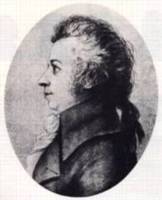February 07, 2006
Gratuitous Musickal Posting (TM)

W.A. Mozart. No, he really looked nothing like Tom Hulce.
From my sickbed testerday afternoon I watched my Netflix DVD of Mozart's Die Entf├╝hrung aus dem Serail ("The Abduction from the Seraglio"), Mozart's first major attempt to establish himself as an operatic composer in Vienna. (The piece premiered there in July, 1782.)
A "Turkish" flavored piece with lots of cymbals and bells, the story concerns the efforts of Belmonte to save his beloved Konstanze from the Pasha Selim, who bought her after her ship had been captured by pirates and seeks to make her love him. Belmonte is aided from the inside by Pedrillo (his former servant) and Blonde, Pedrillo's sweetheart, both of whom were also bought by the Pasha. Osmin (the Pasha's overseer) hates Pedrillo, wants Blonde for himself and is instantly suspicious of Belmonte when he appears at Selim's country estate (disguised as an architect) to attempt the rescue. (Here is a fuller synopsis of the opera.)
Not even the most blind admirer of Mozart is going to argue that this is his best piece of work. It isn't. There are all sorts of dramatic problems with the opera and now and again Mozart himself drives it into the ditch. However, the music is generally very pleasant and also contains some genuinely sublime passages. Further, there are all sorts of tantalyzing hints of things to come - ideas that Gangerl seemed to be trying out that would have their fruition in his later operatic masterpieces.
This particular recording was made in 1987 by Sir Georg Solti and the Royal Opera House Orchestra. If you've never seen the opera before, it strikes me as an excellent place to begin. And if you're familiar with the work, I think you'll like it as well. Some people don't care for Solti's conducting on the grounds that it is too rigid. I've never thought that way, instead admiring his crispness. And here, he delivers the two elements crucial to any performance of Mozart: clarity and grace.
As for the singers, I thought them pretty good as well. The sole exception as far as I was concerned was Lillian Watson as Blonde. She was appropriately lively and snappish, but had a tendency to sing sharp sometimes and also to shriek some of her top notes. Inga Nielson as Konstanze, on the other hand, had a beautifully round and clear voice that lost none of its quality in the higher registers. (I could easily see her singing the Queen of the Night.) And by golly does Mozart put her through her paces: Konstanze has brutal back to back arias in Act II ( "Traurigkeit ward mir zum Lose" and "Marten aller Arten") that together must run for better than twenty minutes and contain just about every dirty trick a composer could pull on a soprano. By the time Nielson collapsed in grief at the end of the scene, she was heaving like she'd just run the Derby.
As for the male parts, Deon van der Walt did fine as Belmonte, although he looked exactly like Eric Idle's Bertholt from The Adventures of Baron Munchausen and his acting consisted of not much more than putting his hands to his head to register surprise, grief or joy. Lars Magnussan, as Pedrillo, looked like Pat Sajak's little brother. Also, his collar must have been too tight because his eyes bulged alarmingly. The comic foil Osmin was played by Kurt Moll, who I've seen sing the Commendatore in Mozart's Don Giovanni (also with Solti). This part is one of pure silly caricature and Moll played it to the hilt - oversized, flowing robe, hideously dyed red beard, and lots of learing and bellowing. (He was also making cast members giggle with his ad-libs.)
The only weak point I could see in the singing was in some of the ensemble passages. Pedrillo and Osmin galloped through the wine duet way too fast (this was Solti's fault) and the couples just didn't seem to mesh that well when singing in quartet. This might have been the fault of the sound recording, but every now and again they simply seemed a bit off key.
Lastly, there was Pasha Selim himself, easily one of the most interesting operatic characters who never actually sings a note. (This piece is not pure opera but instead what is called a singspiel, with spoken dialogue intermixed with sung parts. Mozart did not provide any music for Selim's part.) As played by Oliver Tobias in orangy-brownish face paint, he looked like a moody, broody George Hamilton. The Pasha, we are given to understand, is a renegade, a person with one foot in both the Christian and Muslim worlds, and appreciative of the best both worlds could offer. Often Selim is decked out in the most lavish Turkish costume imagination can contrive. Here, on the other hand, he wore European coat, breeches, neckcloth and wig and was surrounded by plenty of servitors in similar clothes. At the same time, he had Moorish guards, Turkish menials and a harem of burqua-clad women scurrying about the place. It matched nicely with his spoken part, which blends Enlightenment concepts of integrity, mercy and respect, proffers of love to Konstanze and outbursts of stylized Turkish ferocity. Indeed, the most fascinating part of the entire story is watching Selim's development as events unfold - his ultimate nobility in letting the two couples go at the end really comes across well. (In contrast, Belmonte - the stock hero of the piece - looks utterly foolish next to him.)
The sets and costumes were no-nonsense period pieces - with a few tweeks, the Pasha's country estate could easily double as Dorabella and Fiordiligi's sea-side house in Naples. The only blemish was the curtain, which was painted in vivid abstract patterns for reasons that escape me.
This was a live recording, but the audience never intruded on the performance. Furthermore, the camerawork was very well done. The DVD quality was fine, except that there was an odd chirping sound on occassion. Where it came from, I couldn't say.
Overall then, if you enjoy Mozart (and I doubt you'd be reading this far if you didn't) I'd recommend checking this performance out.
Posted by Robert at February 7, 2006 12:58 PM | TrackBack

 Image courtesy of the lovely and talented
Image courtesy of the lovely and talented 